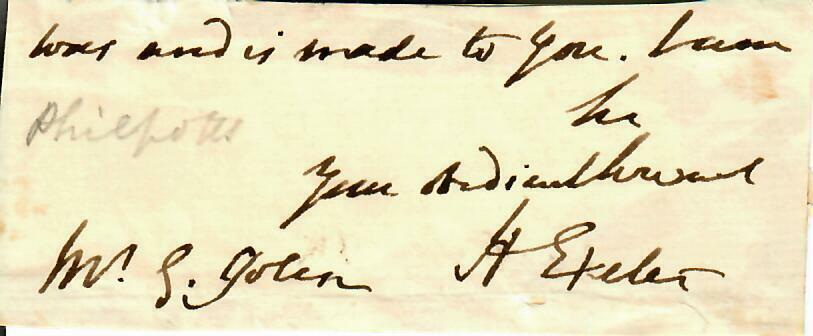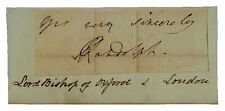RARE "Bishop of Exeter" Henry Phillpotts Clipped Signature For Sale

When you click on links to various merchants on this site and make a purchase, this can result in this site earning a commission. Affiliate programs and affiliations include, but are not limited to, the eBay Partner Network.
RARE "Bishop of Exeter" Henry Phillpotts Clipped Signature:
$299.99
Up for sale a RARE! "Bishop of Exeter" Henry Phillpotts Clipped Signature.
1778 – 18 September 1869), often called "Henry of Exeter", was
the Anglican Bishop of Exeter from 1830 to 1869. One of England's
longest serving bishops since the 14th century, Phillpotts was a striking
figure of the 19th century Church. Henry Phillpotts, D.D., Bishop of Exeter,
was born on 6 May 1778 at Bridgwater, Somerset, England, the son of John land agent to the Dean and Chapter
of Gloucester Cathedral. He
grew up in Gloucestershire, and was
educated at Gloucester Cathedral school. John Phillpotts, Member of Parliament for Gloucester city between 1830 and 1847, was his elder
brother. Two other brothers, Thomas and George, and two sisters, Isabella and
Sibella, reached adulthood; a number of other siblings died in infancy or
childhood. Elected
a scholar of Corpus Christi, Oxford, at the age of only thirteen, he took his BA at Corpus Christi, and his MA at Magdalen College in
1795, aged eighteen. He took holy orders in 1802, being ordained deacon by Bishop Randolph and priest by Bishop Majendie in 1804. He was selected
university preacher in 1804, in which year he published his Sermon on 5
November, delivered before the University of Oxford. In
September 1804 he was presented to the Crown living of Kilmersdon, near Bath, which he held until 1806. He does not appear ever to have resided there,
duty being taken by a curate named Daniel Drape, according
to the parish registers. Philpotts married in October 1804 and
in 1805 became vicar. He was appointed chaplain to Bishop Middleham, County Durham, in the succeeding year. For
twenty years he was chaplain to Bishop Shute Barrington, in the Diocese of Durham. In
1808 he received his next preferment, being collated by the bishop to the large
and important parish of Gateshead—within a year his rapid
advancement continued with the collation to the ninth prebendal stall in Durham Cathedral. "That at the age of 31 he should
already have held four livings and a prebendal stall testifies to the regard in
which he was held by his diocesan, and the usefulness of his
marriage connection." He now resided for a considerable part of the year
at Durham, and on the chapelry of St Margaret in the
city becoming vacant, he was presented to it by the Dean and Chapter on 28
September 1810. On 30 December 1815 Philpotts received yet further preferment,
being collated by the bishop to the second canonry in the Cathedral, the emoluments of which were considerably higher than those
of the ninth. This he held for five years, at the end of which period his
literary and controversial abilities brought him into advancing prominence. After
holding the rich living of Stanhope, Durham, from
1820, and the Deanery of Chester from 1828, he was consecrated Bishop of Exeter in 1831, holding with the see a residentiary canonry at Durham which he secured permission to hold along with
his bishopric, one of the last cases of the benefice in commendam by which medieval and later bishops had often profited. Philpotts
recognised the need to look after his family, extensive as it was — he had
18 children. When he was offered the bishopric in Exeter he realised that the
stipend (£3,000) was not enough to support his family, so he asked to retain
his parish of Stanhope, in Durham (as a non-resident), which would be worth an
additional £4,000 a year. As a compromise he was instead offered the canonry
at Durham which was
worth a similar amount, and was a post which he continued to hold until his
death. He was one of the last of a clerical aristocracy, which, whatever their
origin, expected to live on a scale comparable to that of the nobility. As
bishop he was a strict disciplinarian, and did much to restore order in a diocese whose clergy had become extraordinarily
demoralized and over which he wielded considerable power. The
diocese at that time extended from the Somerset and Dorset borders to the Isles of Scilly in Cornwall. His episcopate was characterized by the
establishment of many new parishes in Cornwall and considerable evangelical
efforts. In
1841 he built for himself a palace at Torquay, Devon. Bishopstowe (now the Palace Hotel)
served as the bishop's residence, which he preferred as a home to the Bishop's
Residence attached to Exeter Cathedral. The gardens in the 25 acres (100,000 m2)
of private land stretching to the sea are still a major attraction today
together with the Bishop's Walk at the local beauty spot of Ansteys Cove. Phillpotts
was aware that his appointment to Exeter was not popular locally and knowing of
his unpopularity he at times took measures to protect himself from it. He
admits in a letter to Ralph Barnes, his secretary, on 14 December 1830 to being
"Cautious...in admitting adverse newspapers to my table, yet the caution
has not prevented me from hearing of the extreme unpopularity of my appointment
to Exeter." 1831 saw Phillpotts as the victim of the Guy Fawkes Night custom of burning effigies of clergymen;
knowing his reputation he took action by requesting protection, thus the 7th
Yeomanry Cavalry filled the palace at Exeter, whilst the crowd in the cathedral
yard burned Phillpotts in effigy; .... hollow turnip as head and candle as
nose, clad in mitre and lawn sleeves... (Chadwick I, 1997, p 29) In 1848 he
placed an appeal in The Guardian of
5 January 1848, for help for the poor of Devonport; his request was answered by Lydia Sellon who was just about to travel to Italy for
her health. Philpott's inspiration of Sellon led to the formation of an
Anglican order which Sellon led.

Related Items:
RARE "Bishop of London" John Randolph Clipped Signature Mounted
$279.99
RARE "Bishop of Exeter" Henry Phillpotts Clipped Signature
$279.99
RARE "Bishop of Exeter" Henry Phillpotts Hand Written Letter
$349.99



